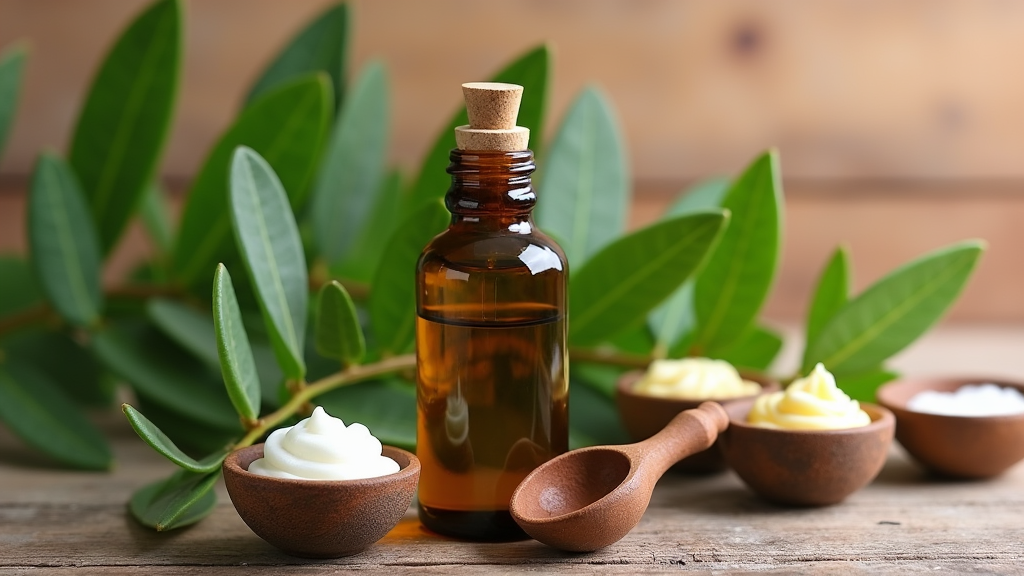Tea tree oil is a natural remedy that has found a spot in lots of bathroom cabinets and skin routines. This essential oil is made from the leaves of the Melaleuca alternifolia plant, which grows in Australia, and it’s famous for its strong, sharp scent and a load of unique perks. While many people think of it for zapping breakouts or freshening up their scalps, tea tree oil’s abilities actually reach much further. Let’s get into what tea tree oil really is, how it’s put to use, and the key things to remember if you want to make the most of it.

What Exactly Is Tea Tree Oil?
Tea tree oil has a long history with Aboriginal Australians, who used it for generations on minor cuts, scrapes, and skin troubles. They would crush the leaves and put them right on the problem area. These days, the oil is steamed from the leaves and bottled for use around the world.
The real standout feature of tea tree oil is its powerful mix of plant compounds, especially terpinen-4-ol. This specific ingredient gives tea tree oil its well-known abilities to fight off bacteria, fungi, and inflammation. Tea tree oil is highly concentrated, so you only need a drop or two at a time. If you’ve ever smelled it, you’ll never forget the strong, bold scent it leaves behind.
Main Benefits of Tea Tree Oil
Tea tree oil has a wide range of uses both for DIY remedies and in ready-made products. Here are a few ways it comes in handy for everyday needs:
- Acne help: Used the right way, tea tree oil can shrink pimples and soothe redness. It’s often part of spot treatments or diluted toners.
- Battling athlete’s foot and nail fungus: The antifungal properties make it a good addition to creams and foot sprays, helping deal with tough fungal problems on your feet and nails.
- Soothing cuts and bug bites: Put a diluted drop on scrapes or bites to help with itching and keep you from scratching.
- For scalp concerns: Shampoos with tea tree oil calm flaky or itchy scalps and can help your scalp feel better overall.
- Household cleaning: Adding a few drops to a spray bottle with water creates a natural cleaner for surfaces, keeping things fresh and clean without harsh chemicals.
How Does Tea Tree Oil Work?
The good stuff in tea tree oil works by breaking through the outer layers of certain bacteria and fungi. The main player, terpinen-4-ol, and its chemical buddies, punch holes in the wall of those unwanted guests, making it hard for them to grow or spread. So, for skin problems, tea tree oil doesn’t just cover things up—it tries to tackle the cause directly.
Beyond its germ-fighting abilities, tea tree oil can also calm irritated skin and reduce swelling. That makes it useful for bug bites, sunburn, or random redness—diluted tea tree oil might help you bounce back quicker by soothing the area.
Ways to Use Tea Tree Oil Safely
With its strength and concentration, tea tree oil needs a little respect. You shouldn’t put it full-strength on your skin. Here’s how to keep things smart and safe when using it:
- Dilute it: Mix a few drops with a carrier oil, like jojoba or coconut, before applying to your skin. This helps avoid irritation.
- Test a small area: Try a little bit on a small patch of skin, especially if you have sensitive skin, just to make sure you don’t react badly.
- Keep it away from eyes and open skin: Tea tree oil stings if it lands in your eyes or on a big wound, so use care around delicate parts.
- Don’t overdo it: Use just enough for the job—this is a case where less is definitely more.
- Check the product label: Go for pure tea tree oil without fillers. Pick products with Melaleuca alternifolia listed as the only ingredient.
Common Issues and What to Watch For
Like any natural remedy or essential oil, there are a few issues to watch out for with tea tree oil:
- Skin Irritation: Some folks, especially if they have sensitive skin, might notice tingling, burning, or a rash. If that happens, wash it off right away and use a milder dilution or skip it.
- Allergic reactions: Although rare, itching, swelling, or hives are a bad sign. It’s a good idea to stop using it and avoid tea tree oil in the future if these pop up.
- It’s toxic to swallow: Tea tree oil should only be used outside your body—never take it by mouth. Keep it away from kids and pets.
- Possible sun reaction: Sometimes, tea tree oil can make your skin more sensitive to the sun. If you put it on and step outside for a while, think about covering up or washing it off first.
How to Store Tea Tree Oil
To keep tea tree oil fresh, stash it in a cool, dark spot such as your medicine cabinet. Heat and sunlight break it down faster, so always put the cap on tight and avoid leaving the bottle out by a window or in a hot room.
Getting Results: Real-Life Uses for Tea Tree Oil
There are loads of smart ways to use tea tree oil every day, especially for skin and added cleaning power. Here are a few ideas you can try at home:
- Pimple helper: Blend a drop or two with aloe vera gel and dab onto breakouts as needed.
- Scalp boost: Mix a few drops into your shampoo if you deal with an itchy or flaky scalp; it works well for most hair types.
- Laundry deodorizer: Drop a little in your washing machine alongside towels or gym clothes for fresh, odor-free linens.
- Surface cleaner: Mix a splash of tea tree oil with water and vinegar in a bottle, and use it to wipe down counters and sinks.
- Shoe refresher: Add some oil to a cotton ball and leave it in your shoes overnight for a fresh smell in the morning.
For every use, make sure the oil is well diluted and don’t saturate things—a little goes a long way and avoids overpowering your space.
Picking Quality Tea Tree Oil
With so many varieties in the store, it can get confusing to pick good tea tree oil. Here’s how I sort through the choices:
- Check for 100% pure oil: The only thing on the ingredients list should be Melaleuca alternifolia.
- Dark glass bottles: These protect the oil and keep it potent.
- Choose trustworthy brands: Companies that openly share how they source the oil, provide lab results, and stick to good manufacturing standards are safest. An organic label is a plus but not a must.
Before you buy, poke around for brand reviews and look for batch testing if you’re planning to use the oil on your skin. This step can help make sure you get genuine, quality product every time and avoid fakes or diluted options.
My favorite place to purchase oils, click below!
My Doterra referral link: https://referral.doterra.me/4740777
“Here’s a little transparency: Our website contains affiliate links. This means if you click and make a purchase, we may receive a small commission. Don’t worry, there’s no extra cost to you. It’s a simple way you can support our mission to bring you quality content.”
Frequently Asked Questions
Can tea tree oil solve all kinds of acne?
Tea tree oil can help with mild or occasional acne. But for tough, chronic, or really severe cases, check in with a dermatologist for other options. Professionals can give targeted advice if regular remedies just aren’t cutting it.
What if you use too much tea tree oil by accident?
Rinse the skin right away using soap and cool water. If irritation continues, put on a fragrance-free, gentle moisturizer to soothe your skin.
Is it okay to use tea tree oil on pets?
Not at all. Tea tree oil is dangerous for animals—even in very small amounts. Always use pet-safe treatments for your furry friends.
Final Thoughts
Tea tree oil stands out for being useful in plenty of ways, from skin care to keeping things clean, as long as you use it thoughtfully. All it takes is a small amount, a gentle touch, and always mixing with a base oil or cream if it’s going on your skin. Whether it’s for your cleaning routine, DIY face sprays, or even freshening up laundry, a little bottle of tea tree oil can be a staple that gets used all the time.
Natural products come with their own set of pros and cons, but tea tree oil’s spot in routines everywhere is earned. Stick with safe application and careful sourcing, and it can be a helpful, trusty option in your toolkit for many years ahead.
